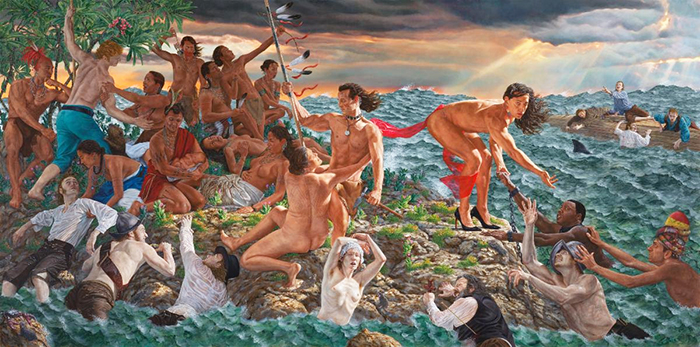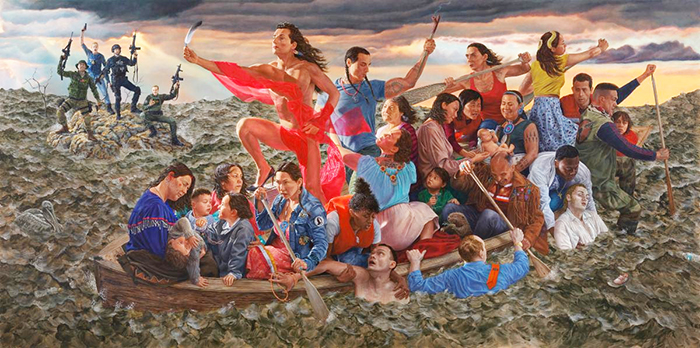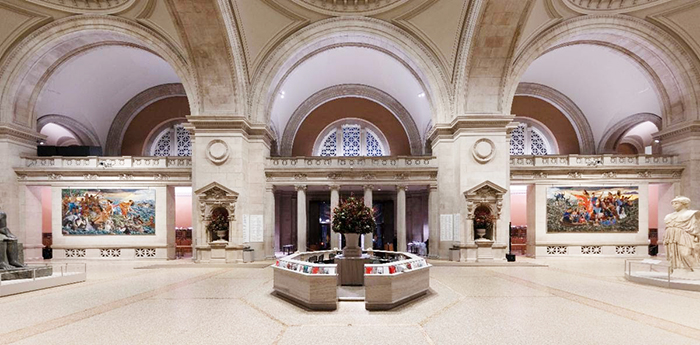CulBeat Express
2019.12.17 14:35
메트뮤지엄 인디언원주민 작가 켄트 몽크맨 회화 전시(12/17-4/9, 2020)
조회 수 1451 댓글 0
Monumental Paintings by Kent Monkman Unveiled at The Met
Works inaugurate new series of contemporary commissions in the Museum's Great Hall
December 17, 20019-April 9, 2020
The Met Fifth Avenue, The Great Hall

Kent Monkman, (Canadian, b. 1965. Welcoming The Newcomers, 2019. 132" x 264". Acrylic on Canvas. Courtesy of the artist. Photo by Joseph Hartman
(New York, December 17, 2019)—The Metropolitan Museum of Art today unveiled two monumental new works by Cree artist Kent Monkman in the Museum's main entrance hall. The Great Hall Commission: Kent Monkman, mistikôsiwak (Wooden Boat People) consists of two paintings—Welcoming the Newcomers and Resurgence of the People—that will be on view through April 9, 2020. The installation is part of a new series of contemporary commissions at The Met in which the Museum invites artists to create new works of art to establish a dialogue between the artist's practice, The Met collection, the physical Museum, and The Met's audiences. Monkman's paintings reappropriate images, motifs, and techniques from art history to express Indigenous people's experiences and histories, subverting the predominate narratives of Euro-American culture, while also addressing present-day issues.
The installation is made possible by Marilyn and Charles Baillie and Rosamond Ivey.
Additional support is provided by the Hal Jackman Foundation and the Director's Fund.
"The Met's new series of commissions presents contemporary art in unexpected places around the Museum, inviting dialogue within the rich context of The Met's architecture and galleries," said Max Hollein, Director of the Museum. "The visually striking and thought-provoking paintings that Monkman has created join a legacy of works made by artists drawing inspiration from the collection—in this case, early American art, including Emanuel Leutze's iconic Washington Crossing the Delaware (1851)—and that speak to present-day ideas and events. It's an important moment to witness the voicing of previously underrepresented perspectives in such a prominent and symbolic location at The Met. These works represent a painterly reevaluation of history and a contemporary perspective on history painting."

Kent Monkman, (Canadian, b. 1965). Resurgence of the People, 2019. 132" x 264". Acrylic on Canvas. Courtesy of the artist. Photo by Joseph Hartman
Sheena Wagstaff, Leonard A. Lauder Chairman of Modern and Contemporary Art at The Met, added, "Cribbing from iconic images by European and American artists—Peter Paul Rubens, Augustus Saint-Gaudens, Eugène Delacroix, and Thomas Crawford, among them—Monkman takes on the hallowed artistic conventions of depicting history and mythology, inserting intertwined themes of arrival, migration, displacement, and Indigenous disenfranchisement. Presented in the inner sanctum of the Museum's entrance hall, these radical paintings act as a different kind of portal, welcoming and signaling new interpretations of the Museum's encyclopedic collections."
Kent Monkman commented, "In creating these paintings I was inspired, not only by the historic artworks in The Met collection but also by the history of Manhattan itself. For thousands of years, these lands have been a meeting center for trade and diplomacy for many Indigenous nations, including the Lenape, until they were displaced by European settlers. These paintings reference Manhattan's important role as a portal for immigration into North America and also the impact our rising sea levels will have on the millions who could be displaced in the not-too-distant future."

Featuring numerous references to works in The Met collection, the two paintings that comprise mistikôsiwak: Wooden Boat People (Welcoming the Newcomers and Resurgence of the People) evoke the relationship between people native to Turtle Island—the name many Indigenous people use for North America—and newcomers to their lands. The commission's primary title derives from a Cree word meaning "wooden boat people" that originally applied to French settlers but is used here to refer to all Europeans who colonized the "New World." Prominent in each of the related compositions is the larger-than-life figure of Miss Chief Eagle Testickle, Monkman's shape-shifting, time-traveling alter ego, who pays tribute to the tradition in Indigenous cultures of the "Two Spirit," a third gender and non-binary sexuality. Miss Chief, whose name plays on the words mischief and egotistical, also refers to the Cree trickster figure, who challenges conventional beliefs and wisdom in traditional stories.







